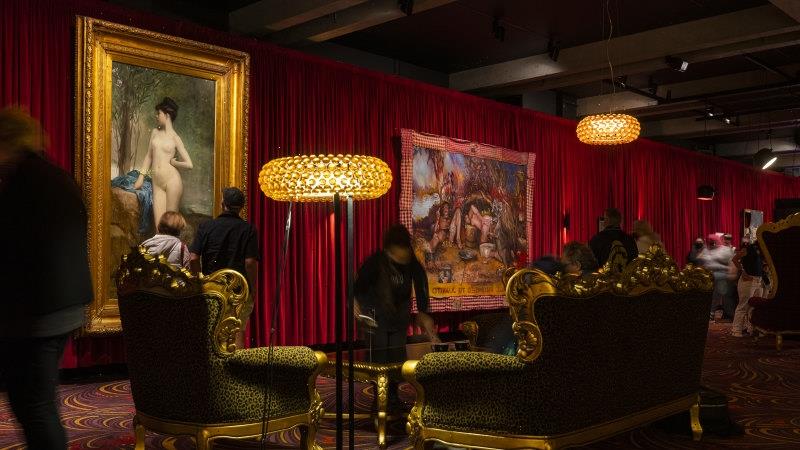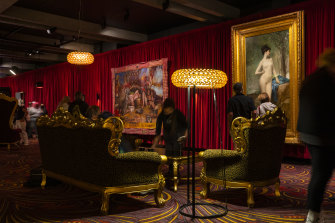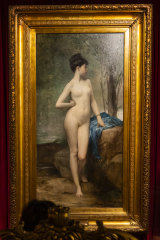How beautifully Chloe glows, flatteringly lit against plush red velvet drapes, this so-called Melbourne icon, on her first venture interstate in 135 years.
Chloe, on ‘holiday’ at MONA.Credit:MONA
At first it seems an odd proposition. The classic 19th century French nude now hangs at Hobart’s MONA, a museum with a well-founded reputation for the contemporary and confronting. On holiday, if you like, from her usual spot at Melbourne’s historic pub Young & Jackson, where she has reigned for generations on the first floor in the bar that takes her name.
It was MONA owner David Walsh’s idea to bring Chloe to Hobart so Tasmanians could savour a drink with her too. He declines to be interviewed about Chloe. Wise, perhaps: a 60-something man not known for his subtlety might get into strife discussing the merits (or otherwise) of a painting whose real-life model was just 17, and whose life ended tragically. Walsh defers to MONA’s senior research curator Jane Clark, whose mission it was to lure Chloe to Hobart on his behalf.
Partly, says, Clark, it was the boss setting his curators a test. MONA had managed to borrow the National Gallery of Victoria’s prized Picasso, Weeping Woman, in 2012, for its Theatre of the World exhibition, and has since borrowed from the British Museum and the V&A, and a host of state galleries.
“So there probably was a little element of that – you’ve borrowed the Picasso from the NGV, see if you can extract Chloe from Young & Jackson,” Clark says.
The painting raises questions about art and the treatment of women in art.Credit:MONA
Clark discovered Chloe is heritage-listed along with Young & Jackson, considered part of the pub’s intrinsic fabric, and required a heritage permit to leave the hotel. A certain pandemic further complicated and delayed Chloe’s journey on the Spirit of Tasmania a couple of weeks ago, meticulously packaged, in her own cargo container. She will hang near MONA’s Void Bar until mid-April, in a gallery with the kind of patterned carpet that would do a pub proud.
Somehow, Chloe looks right at home next to Juan Davila’s painting Arse End of the World (an X-rated political satire of Burke and Wills, Hawke and Keating) and near Mat Collishaw’s photograph Bullet Hole (a giant close-up of a head wound). Amid this lot, Chloe provides a moment of visual repose: poised, hand on hip, avoiding the viewer’s gaze, face turned left. Is there a touch of disdain in her expression? Is she mightily tired of being ogled, idolised and denounced?
“Chloe’s no stranger to controversy,” says Young & Jackson venue manager Megan Herring. “So MONA seemed like a really wonderful connection.”
Chloe fits the preoccupations that drove Walsh to create his museum – the biological imperative, sex, death. The painting scandalised those of prim constitution and religious conviction when it was exhibited at the National Gallery of Victoria in 1883, on loan from Melbourne surgeon Dr Thomas Naghten FitzGerald. She lasted only three weeks.
“There were pages of letters to the paper, condemning it or praising it,” says Clark. “Dr FitzGerald asks for it back because he thought the controversy was getting out of hand.”
Some criticised Chloe not for its pubescent nudity but for its conventionality. Created in 1875 by Jules Lefebvre, a member of the French Académie des Beaux-Arts, Chloe won a gold Medal of Honour at the Paris Salon. But even in its day the picture was slipping out of fashion, as impressionists thrilled critics with dynamic colour and brush strokes.
“There was a bit of a conflict between that kind of polished, classical, you-can’t-even-see-a-brush-stroke realism, and the much more painterly informal response to subject matter [of] the impressionists,” says Clark.
“But, when Chloe came to Australia, artists like Frederick McCubbin wrote in favour of it, saying this is a wonderful painting … [it was] exactly the kind of thing they were trying desperately to learn to paint at the National Gallery school and they didn’t even have nude models.”
The real-life model for Chloe was a teenager called Marie who reportedly took her own life, possibly after a failed love affair. Lefebvre painted her as the Greek goddess of fertility, Demeter, also known as Chloe.
The painting first travelled to Australia in 1879 for Sydney’s International Exhibition, then to Melbourne’s in 1880, where it was bought by Dr FitzGerald. After the doctor’s death, Chloe sold at auction in 1909 to publican Henry Figsby Young and has lived at the Young & Jackson hotel ever since.
Past NGV directors have considered buying the work, but prevaricated. Clark wonders how different the painting’s fate might have been. Would Chloe have been deaccessioned when salon pictures went out of style? Would it still have taken on a life of its own?
“It’s the same with the Mona Lisa or the Girl with a Pearl Earring, where certain artworks take on a living essence, a living personality,” says Clark.
Would Australian soldiers have written letters to Chloe from the trenches had the painting never hung in a pub? Unlikely, says Clark.
“For some of those soldiers, perhaps she was the first and last naked woman they ever saw. Do we condemn the fact that they were having a beer with her before they went to war? I don’t know … the painting throws up all kinds of questions about art and attitudes to women and so on, without definitive answers,” says Clark.
Chloe’s return to Young & Jackson for Anzac Day was non-negotiable.
Says Herring: “A big part of the discussion was how long she’d be away for, but in particular that she needed to be back here for Anzac Day, ready to receive the crowds.”
Most Viewed in Culture
From our partners
Source: Read Full Article


